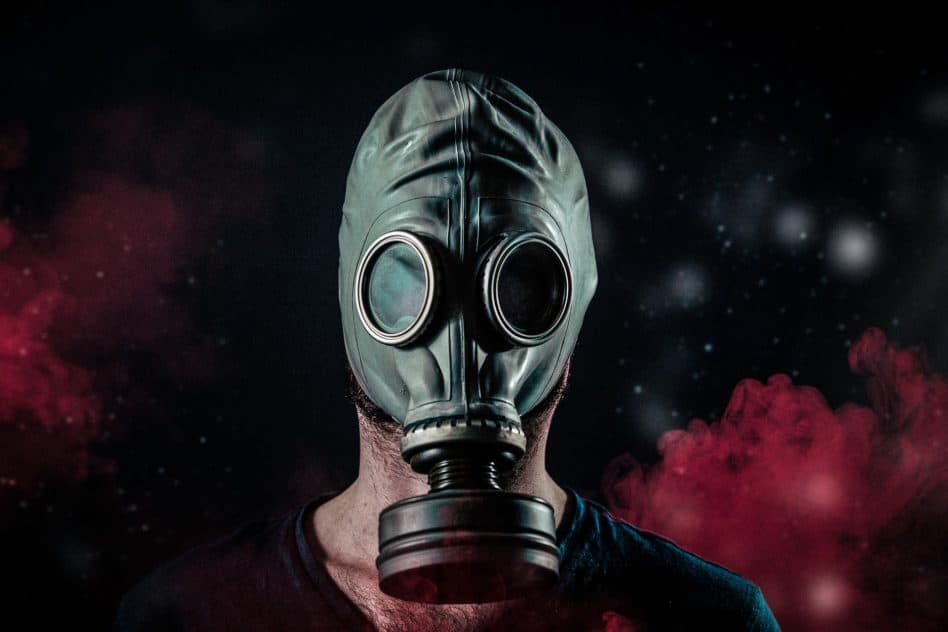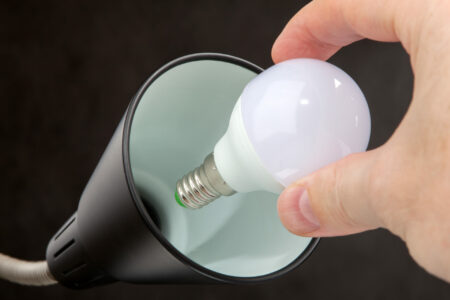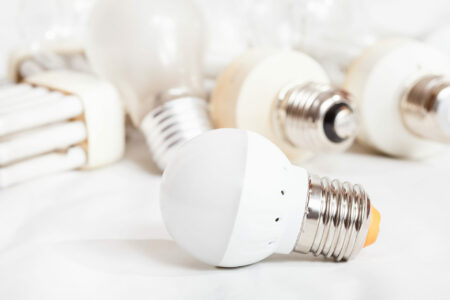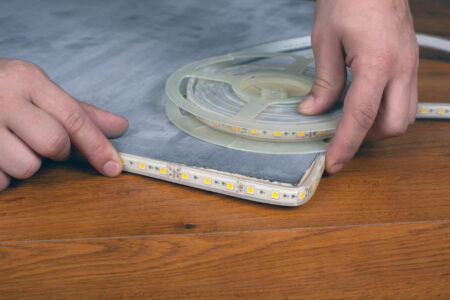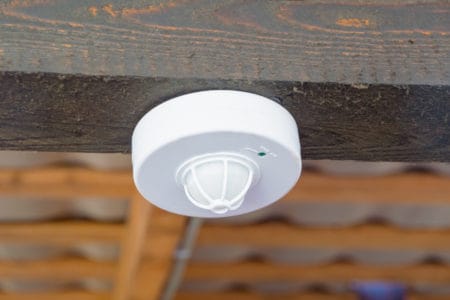One of the main concerns of people considering LED lighting is whether or not they emit UV rays and radiation. There are sources that say that LED lights do not emit UV rays at all. But some quarters say that this is not entirely an accurate statement. So people are worried that using LED lighting might be harmful to their health. In this guide we will elaborate if LED lights emit UV rays or other radiation.
Radiation of LED lights
The best part first: Standard LED lights for home use do not emit any dangerous amount of UV rays. The only exception are special LEDs that are designed to produce UV light that do so. But for the majority of LED lights this is not the case. We also need to understand why people are wondering about possible radiation.
The truth is that some people are worried that using LED lighting might be harmful to their health. Others want to know if using LED lights helps protecting decors, furniture, artifacts or artwork from discoloration and aging.
What are UV rays and radiation?
Ultraviolet (UV) radiation is a kind of electromagnetic radiation that emanates from the sun. It can also come from man-made sources. There are many different kinds of radiation. These range from very high-energy radiation like x-rays to very low-energy radiation like radio waves. In the middle of this spectrum are UV rays.
They emit more energy than visible light, but not as much as x-rays. We cannot detect UV radiation with our eyes. But it can cause materials to fluoresce or light up when it falls on them.
In what ways are UV rays harmful?
One of the ways UV radiation can harm us is by damaging the DNA in our cells. This can lead to cancer. But since UV rays are not strong enough to penetrate deep into our bodies, the main effect is only on the skin. Thus, exposure to UV rays can cause skin cancer.
The cornea of our eyes can absorb high doses of UV light. They are very sensitive to UV radiation. This can make the cornea cloudy which is a condition known as snow-blindness. Other effects of exposure to UV radiation are cataracts, macular degeneration, and corneal damage. This can ultimately lead to blindness.
Color degradation is another concern with UV rays. Because of UV emissions, damage can be caused to carpets, painted surfaces, shades, and more. They also weaken plastics and are damaging to plants and animals. UV radiation from light sources is also known to attract different kinds of insects.
Do LED lights emit UV rays and radiation?
It is first important to know where you are using your LED lighting and what purpose you are trying to achieve before asking whether your LED light emits UV radiation. The reason for this is that using LED lighting in your home or office is very much different from using LED lighting for medical areas and other technologies that use UV radiation.
Standard LEDs emit a very small amount of UV rays. This small amount is even less than what is produced by sunlight. This insignificant amount of UV light produced by LED lighting in your home is not dangerous for your health. But there are LEDs designed on purpose to produce UV light or UV LEDs. These are the ones used for medical treatments, chemistry, photography, and for tanning, for which UV rays are necessary.
Ultraviolet LEDs have a good future in many applications like the life sciences and certain industries even though we cannot see the light. Particularly, UV LEDs can revolutionize disinfection and sterilization. It could help bring safe water worldwide. It could also bring safer conditions for medical facilities.
Do white light LEDs emit UV rays?
We first need to understand that LEDs are not capable of emitting white light. Lights that LEDs can produce are the three primary colors of red, blue, and green and the different shades of these colors. But they cannot produce white light.
Brilliant blue lights were created in 1993. Brilliant blue LEDs are the only LEDs that do produce a substantial amount of UV light. Scientists found out that when brilliant blue LEDs are coated with phosphor, the UV light is converted to white light.
Blue light vs Phosphor
Do white light LEDs used in general lighting applications emit UV rays? Although the brilliant blue LEDs used in creating white light LEDs emit some UV rays, the amount is so small that we can say that these white light LEDs do not emit any UV rays. This is because of the phosphors in the LED lamp that convert the UV light to white light.
But any damage to the phosphorus will result in the emission of UV rays together with the white light. This is the only risk in this case. There is not enough UV light emitted by white light LEDs to pose a health risk. This is why LEDs have become the lighting type of choice for homes, offices, and even museums since it can preserve and maintain the original colors of their valued artifacts.
And even then, standards have been set relating to radiation emissions from general-purpose lighting. If bulbs exceed allowable levels of UV light, the packaging is required to be labeled with a caution label. FDA requires lamp manufacturers to provide this caution if warranted. But most lights in the market for general-purpose fall below allowable UV levels, so there are no such warnings put in place.
What types of lights emit UV rays?
Some types of bulbs or lights produce UV rays. Some of these are tanning lights, fluorescent bulbs, reptile basking bulbs, and incandescent bulbs. The most popular of these bulbs are the incandescent bulbs. They are commonly used to light our homes. Although they emit some amount of UV rays, it is quite small to cause sunburns or health problems.
Another type of bulb that produces UV rays is reptile basking bulbs. These bulbs provide heat that reptiles need to maintain their life activities at the ideal level. It is like being exposed to the sun’s rays. These types of bulbs emit more UV rays than fluorescent or incandescent light bulbs.
Fluorescent bulbs and UV rays
Two kinds of fluorescent bulbs are commonly used. One is the compact fluorescent light or CFL and the fluorescent tube lighting. Fluorescent bulbs emit more UV radiation than incandescent bulbs. But then, the amount of UV rays they emit is still not dangerous to your health. It cannot cause eye pain or sunburn.
But if you are very sensitive to UV, you may be affected by the amount of UV produced by CFLs. Thus, it is recommended that you keep a distance of 30 cm or more from this light source. UV light emissions of fluorescent bulbs should not be of any great concern as long as they are installed at least 25 cm away.
Halogen and UV rays
A Halogen bulb emits a substantial amount of UV rays and it works at very high temperatures. This is the reason why halogen bulbs need special filters and casings. This is to avoid harmful UV light and radiation. If you are using fluorescent lamps and fixtures and you are worried that you are getting UV radiation, then consider exchanging them with LED lamps and fixtures. Modern LED lamps do not emit UV radiation.
If your current fixtures don’t have a diffuser to cover them, or you can directly see the lamps, the UV rays may be more widespread and you should do something about it quickly. If you have photosensitive skin, then it would be good to replace your fluorescent lights with LEDs. It would also be good to replace fluorescent lamps with LEDs for bedhead lights, or local or task lighting where you are very near to the fluorescent lamp.
What are the advantages of LED lights?
With LED lighting heat and UV radiation are kept to a minimum. The ability of LED to stifle heat makes it unmatched in its efficiency. All of its energy is expended as light so there is little left for any heat output. If light emits too much heat, it becomes uncomfortable inside a building or in your home. It also stresses your HVAC system and drives your energy costs up. Efficient lighting can help cut your costs.
LED technology is easy to control. LED technology is the most modern lighting option you have. You can control it with mechanisms like dimmers and sensors. You can alter lighting intensity with dimmers. This makes you expend the optimal amount of energy at all times. LED lighting is easy to maintain. LEDs can reduce costs in many ways, including minimizing maintenance.
LED fixtures are not only safe and efficient, but they are also very durable. They live long and retain their color for longer than other lighting technologies. Even if you use your LED lights for several years, you won’t need any maintenance at all. You simply install your LED lights and then forget about them. You don’t even have to replace them often because they have fewer maintenance requirements.
Conclusion
Standard LEDs emit some UV rays but are very close to zero. This makes LED lights a safe solution to use in homes, offices, museums, etc. White light LEDs produce some UV light, but they emit less due to their yellow phosphor layer. LEDs specifically designed to emit UV radiation are needed in medical treatment and other technologies. For home lighting you don’t need to worry that using LED lights might be harmful to your health.
